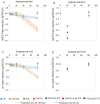Simultaneous inactivation of antibiotic-resistant bacteria and degradation of antibiotic-resistant genes in alkalised human urine
- PMID: 40919206
- PMCID: PMC12411533
- DOI: 10.3389/fmicb.2025.1605625
Simultaneous inactivation of antibiotic-resistant bacteria and degradation of antibiotic-resistant genes in alkalised human urine
Abstract
The coexistence of pharmaceuticals and microorganisms in source separated urine poses a risk for the development of antimicrobial resistance (AMR), especially when urine-based fertilizers are applied to soils. While prior studies have investigated pathogen inactivation in source-separated wastewater matrices, few have evaluated the simultaneous fate of antibiotic-resistant bacteria (ARBs) and their corresponding resistance genes (ARGs) in real urine matrices, particularly under alkaline conditions. Here, we studied the inactivation of β-lactamase-producing Escherichia coli and vancomycin-resistant Enterococcus faecium and the degradation of their respective ARGs (bla CTX - M and van-A) in alkalized, unhydrolyzed urine (pH 10.8 and 12.5) treated with UV (65 W low pressure dichromatic mercury lamp at 185/254 nm), hydrogen peroxide (1.25 g L-1 H2O2), and their combination (UV/H2O2). UV/H2O2 treatment resulted in >7 log10 inactivation of both ARBs, with inactivation rate constants of -0.058 log10 cfu min-1 (E. coli, UV) and -0.093 log10 cfu min-1 (E. faecium, UV/H2O2). In contrast, ARG reduction was limited with UV alone and negligible with H2O2 alone. Gene copy reductions of 3 log10 (bla CTX - M, k = -0.055 log10 copies min-1) and 2 log10 (van-A, k = -0.040 log10 copies min-1) were observed under UV/H2O2. Notably, brief storage (>3 h) at pH 12.5 achieved similar ARB inactivation and ARG reduction as 80 min of UV/H2O2 treatment at pH 10.8, offering a low-energy alternative for sanitizing source-separated urine.
Keywords: fertilizer; hygienisation; microbial risk; pathogens; safe nutrient recycling; source separation; wastewater.
Copyright © 2025 Demissie, Nordin, Simha, Conroy, Sun, Schnürer, Vinnerås and Desta.
Conflict of interest statement
The authors declare that the research was conducted in the absence of any commercial or financial relationships that could be construed as a potential conflict of interest. The author(s) declared that they were an editorial board member of Frontiers, at the time of submission. This had no impact on the peer review process and the final decision.
Figures


References
-
- Alcock B. P., Huynh W., Chalil R., Smith K. W., Raphenya A. R., Wlodarski M. A., et al. (2023). CARD 2023: expanded curation, support for machine learning, and resistome prediction at the comprehensive antibiotic resistance database. Nucleic Acids Res. 51, D690–D699. 10.1093/nar/gkac920 - DOI - PMC - PubMed
-
- Arve P. H., Popat S. C. (2021). Stabilization of urea for recovery from source-separated urine using electrochemically synthesized hydrogen peroxide. ACS EST Eng. 1, 1642–1648. 10.1021/acsestengg.1c00194 - DOI
-
- Batterman S., Mancy K., Wang S., Zhang L., Warila J., Lev O., et al. (2001). Evaluation of the efficacy of a new secondary disinfectant formulation using hydrogen peroxide and silver and the formulation of disinfection by-products resulting from interactions with conventional disinfectants. US EPA Res. Drinking Water Prog. Rev. 22–23.
LinkOut - more resources
Full Text Sources
Miscellaneous

